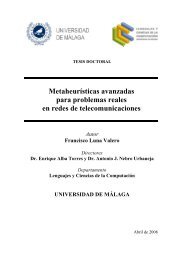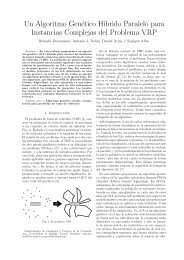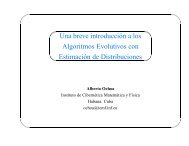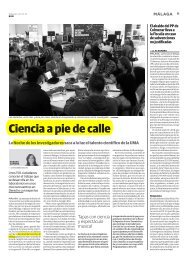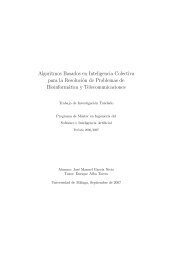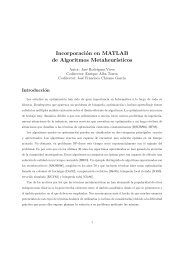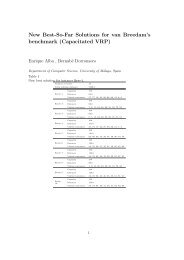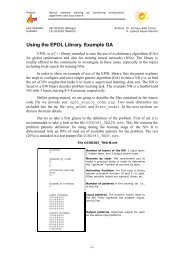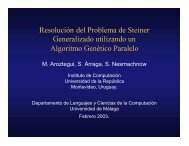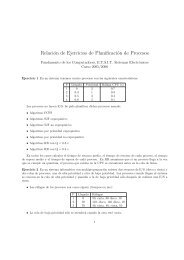Comparing Metaheuristic Algorithms for Error Detection in ... - NEO
Comparing Metaheuristic Algorithms for Error Detection in ... - NEO
Comparing Metaheuristic Algorithms for Error Detection in ... - NEO
You also want an ePaper? Increase the reach of your titles
YUMPU automatically turns print PDFs into web optimized ePapers that Google loves.
Algorithm 1 Pseudo code of Simulated Anneal<strong>in</strong>g<br />
1: S = generateInitialSolution();<br />
2: T = <strong>in</strong>itialTemperature;<br />
3: while not stopp<strong>in</strong>gCondition() do<br />
4: N = getRandomNeighbor(S);<br />
5: ∆E = energy(N) - energy(S);<br />
6: if ∆E > 0 OR random(0,1) < probabilityAcceptance(∆E, T) then<br />
7: S = N<br />
8: end if<br />
9: T = updateTemperature(T);<br />
10: end while<br />
11: return S<br />
SA then updates the temperature us<strong>in</strong>g some sort of decay<strong>in</strong>g method. When<br />
the stopp<strong>in</strong>g criteria is met, the algorithm returns the current solution S.<br />
The energy function <strong>in</strong> this case is the objective function f def<strong>in</strong>ed <strong>in</strong> Equation<br />
(1). S<strong>in</strong>ce we want to maximize this function (the energy), given an energy<br />
<strong>in</strong>crease ∆E and a temperature T, the probability of acceptance is computed<br />
us<strong>in</strong>g the follow<strong>in</strong>g expression:<br />
probabilityAcceptance(∆E, T) = e ∆E<br />
T (2)<br />
One critical function of the Simulated Anneal<strong>in</strong>g is the updateTemperature<br />
function. There are several different ways to implement this method. In our<br />
implementation we used a simple, yet commonly used technique: multiply<strong>in</strong>g<br />
the temperature by a number α between 0 and 1 (exclusive). The smaller that<br />
number is, the faster the temperature will drop. However, if we detect a local<br />
maxima (if the solution isn’t improved <strong>for</strong> a number of iterations) we reset the<br />
temperature to its <strong>in</strong>itial value to explore new regions.<br />
4.2 Parameter sett<strong>in</strong>gs<br />
In a comparison of different k<strong>in</strong>ds of algorithms one problem always poses: how<br />
to compare them <strong>in</strong> a fair way? This problem is aggravated by the fact that the<br />
algorithms work <strong>in</strong> fundamentally different ways: some algorithms search only<br />
one state at a time, some search <strong>for</strong> paths. Some check only one state per iteration,<br />
others check many more states per iteration, etc. This large diversification<br />
makes it very hard to select the parameters that make the comparison fair. The<br />
fairest comparison criterion seems to be the computational time available to each<br />
algorithm. However, this criterion would make it impossible to use the results <strong>in</strong><br />
a future comparison because the execution environment can, and probably will,<br />
change. Furthermore, the implementation details also affect the execution time<br />
and we cannot guarantee that the implementations used <strong>in</strong> the experiments are<br />
the most effective ones. For this reason, we decided to established a common<br />
limit <strong>for</strong> the number of states each algorithm may expand. After a def<strong>in</strong>ed num-






